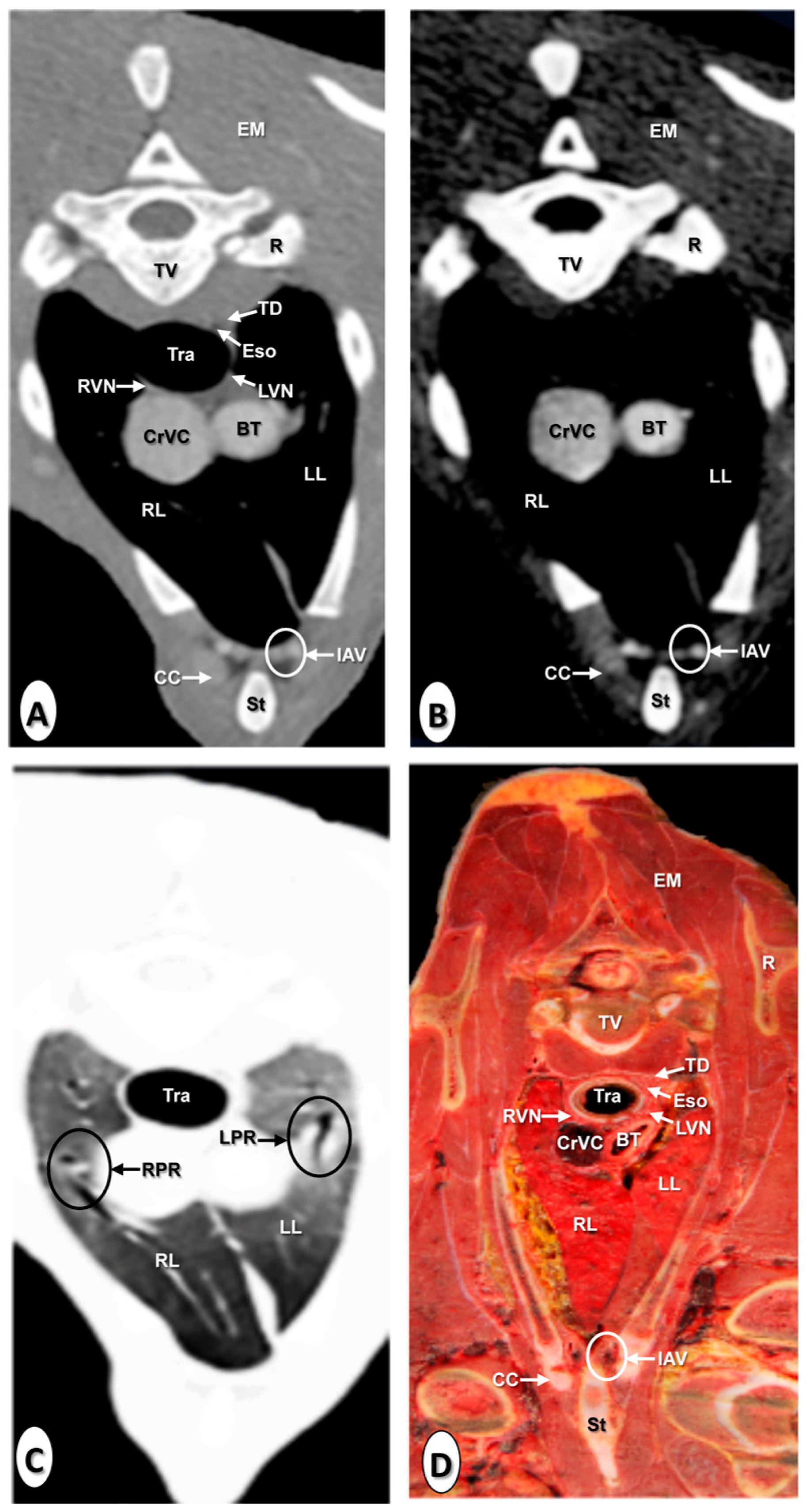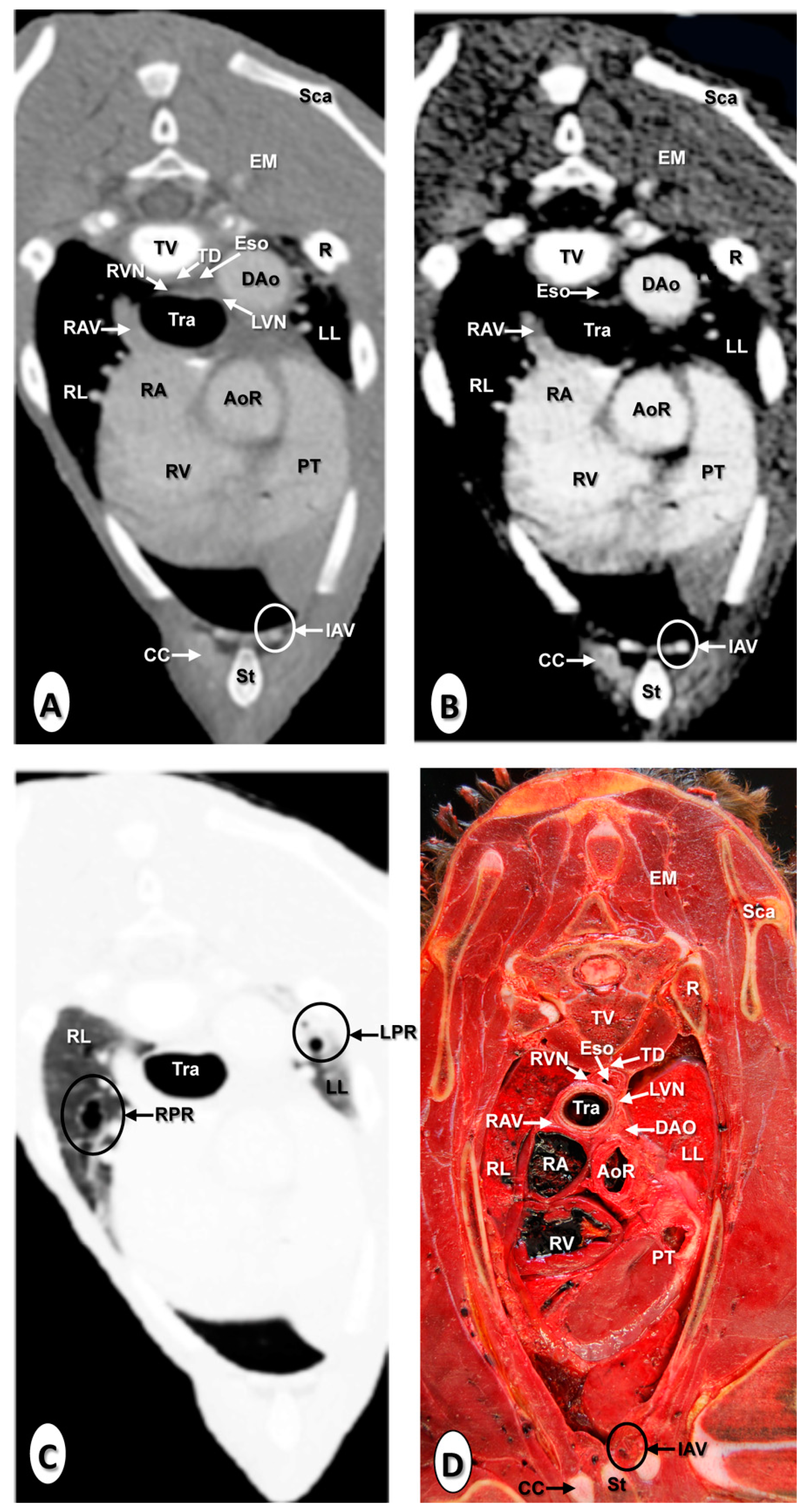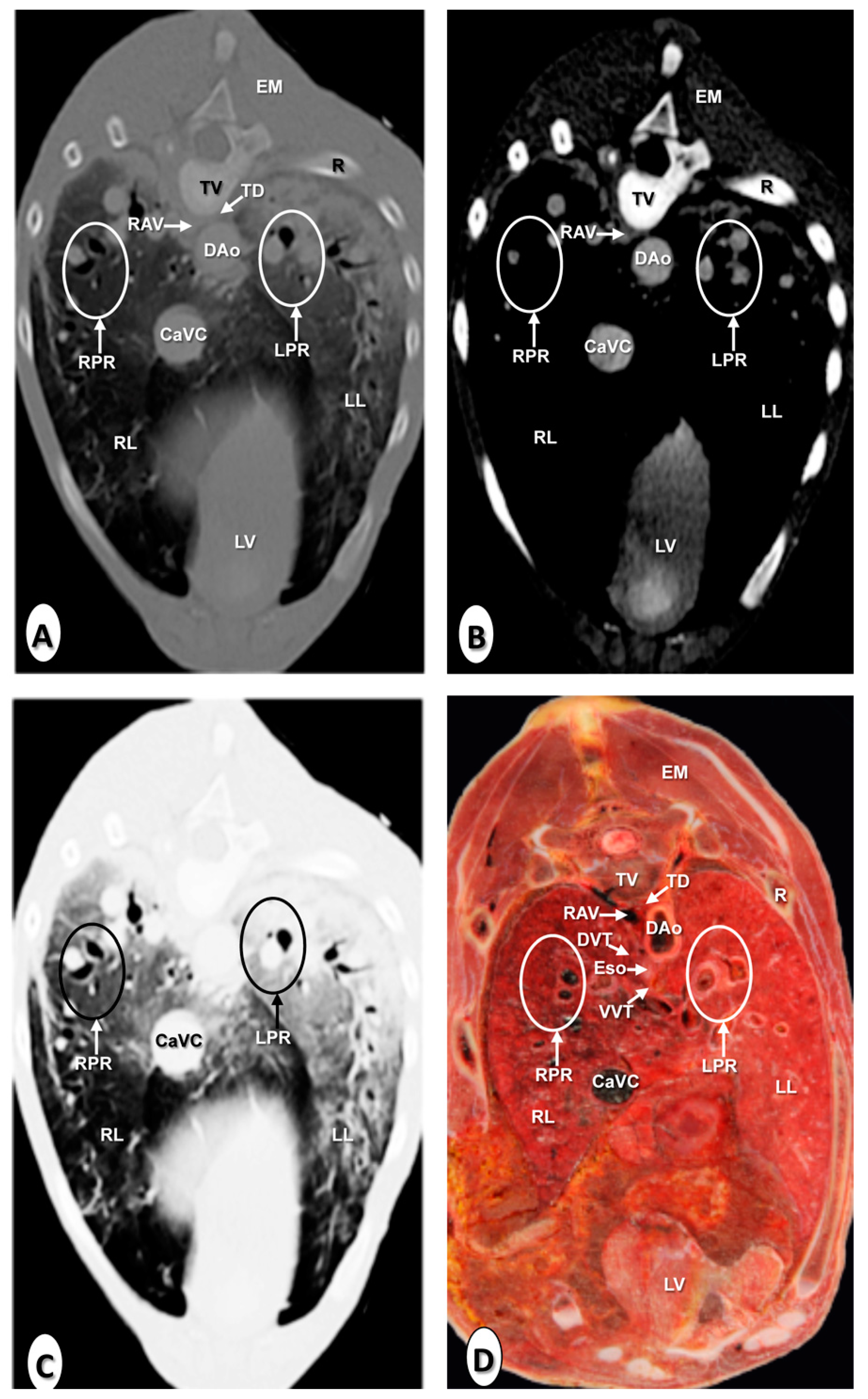Anatomical Assessment of the Thorax in the Neonatal Foal Using Computed Tomography Angiography, Sectional Anatomy, and Gross Dissections
Abstract
:Simple Summary
Abstract
1. Introduction
2. Materials and Methods
2.1. Animals
2.2. CTA Technique
2.3. Anatomic Evaluation
3. Results
3.1. Transverse Computed Tomography Angiography Images
3.2. Anatomical Sections
3.3. Gross Anatomical Dissections
3.4. Cardiac Volume-Rendered Reconstructed CTA Images
4. Discussion
5. Conclusions
Author Contributions
Funding
Acknowledgments
Conflicts of Interest
References
- Lawler, L.P.; Fishman, E.K. Multi–detector row CT of thoracic disease with emphasis on 3D volume rendering and CT angiography. Radiographics 2001, 21, 1257–1273. [Google Scholar] [CrossRef] [PubMed] [Green Version]
- Whiting, P.; Singatullina, N.; Rosser, J.H. Computed tomography of the chest: I. Basic principles. BJA Educ. 2015, 15, 299–304. [Google Scholar] [CrossRef] [Green Version]
- Goo, H.W.; Park, I.S.; Ko, J.K.; Kim, Y.H.; Seo, D.M.; Yun, T.J.; Park, J.J.; Yoon, C.H. CT of congenital heart disease: Normal anatomy and typical pathologic conditions. Radiographics 2003, 23, 147–165. [Google Scholar] [CrossRef] [PubMed]
- Kumamaru, K.K.; Hoppel, B.E.; Mather, R.T.; Rybicki, F.J. CT angiography: Current technology and clinical use. Radiol. Clin. N. Am. 2010, 48, 213–235. [Google Scholar] [CrossRef] [PubMed] [Green Version]
- Kim, T.H.; Kim, Y.M.; Suh, C.H.; Cho, D.J.; Park, I.S.; Kim, W.H.; Lee, Y.T. Helical CT angiography and three-dimensional reconstruction of total anomalous pulmonary venous connections in neonates and infants. Am. J. Roentgenol. 2000, 175, 1381–1386. [Google Scholar] [CrossRef] [Green Version]
- Ferretti, G.R.; Bricault, I.; Coulomb, M. Virtual tools for imaging of the thorax. Eur. Respir. J. 2001, 18, 381–392. [Google Scholar] [CrossRef] [PubMed] [Green Version]
- Mazan, M.R.; Vin, R.; Hoffman, A.M. Radiographic scoring lacks predictive value in inflammatory airway disease. Equine Vet. J. 2005, 37, 541–545. [Google Scholar] [CrossRef]
- Sprayberry, K.A. Ultrasonographic examination of the equine neonate: Thorax and abdomen. Vet. Clin. N. Am. Equine Pract. 2015, 31, 515–543. [Google Scholar] [CrossRef]
- Marr, C.M. The equine neonatal cardiovascular system in health and disease. Vet. Clin. N. Am. Equine Pract. 2015, 31, 545–565. [Google Scholar] [CrossRef]
- Rodríguez, M.J.; Latorre, R.; López-Albors, O.; Soler, M.; Aguirre, C.; Vázquez, J.M.; Querol, M.; Agut, A. Computed tomographic anatomy of the temporomandibular joint in the young horse. Equine Vet. J. 2008, 40, 566–571. [Google Scholar] [CrossRef] [Green Version]
- Powell, S.E. Use of multi-detector computed tomographic angiography in the diagnosis of a parapharyngeal aneurysm in a 6-week-old foal. Equine Vet. J. 2010, 42, 270–273. [Google Scholar] [CrossRef] [PubMed]
- Dahlberg, J.A.; Valdes-Martinez, A.; Boston, R.C.; Parente, E.J. Analysis of conformational variations of the cricoid cartilages in thoroughbred horses using computed tomography. Equine Vet. J. 2011, 43, 229–234. [Google Scholar] [CrossRef] [PubMed]
- van Hoogmoed, L.; Yarbrough, T.B.; Lecouteur, R.A.; Hornof, W.J. Surgical repair of a thoracic meningocele in a foal. Vet. Surg. 1999, 28, 496–500. [Google Scholar] [CrossRef] [PubMed]
- Puchalski, S.M.; Galuppo, L.D.; Drew, C.P.; Wisner, E.R. Use of contrast enhanced computed tomography to assess angiogenesis in deep digital flexor tendonopathy in a horse. Vet. Radiol. Ultrasound 2009, 50, 292–297. [Google Scholar] [CrossRef] [PubMed]
- Vallance, S.A.; Bell, R.J.W.; Spriet, M.; Kass, P.H.; Puchalski, S.M. Comparisons of computed tomography, contrast enhanced computed tomography and standing low-field magnetic resonance imaging in horses with lameness localised to the foot. Part 1: Anatomic visualisation scores. Equine Vet. J. 2012, 44, 51–56. [Google Scholar] [CrossRef]
- van Hamel, S.E.; Bergman, H.J.; Puchalski, S.M.; de Groot, M.W.; van Weeren, P.R. Contrast-enhanced computed tomographic evaluation of the deep digital flexor tendon in the equine foot compared to macroscopic and histological findings in 23 limbs. Equine Vet. J. 2014, 46, 300–305. [Google Scholar] [CrossRef]
- Lascola, K.M.; O’Brien, R.T.; Wilkins, P.A.; Clark-Price, S.C.; Joslyn, S.K.; Hartman, S.K.; Mitchell, M.A. Qualitative and quantitative interpretation of computed tomography of the lungs in healthy neonatal foals. Am. J. Vet. Res. 2013, 74, 1239–1246. [Google Scholar] [CrossRef]
- Lascola, K.M.; Joslyn, S. Diagnostic imaging of the lower respiratory tract in neonatal foals: Radiography and computed Tomography. Vet. Clin. N. Am. Equine Pract. 2015, 31, 497–514. [Google Scholar] [CrossRef]
- Schliewert, E.C.; Lascola, K.M.; O’Brien, R.T.; Clark-Price, S.C.; Wilkins, P.A.; Foreman, J.H.; Mitchell, M.A.; Hartman, S.K.; Kline, K.H. Comparison of radiographic and computed tomographic images of the lungs in healthy neonatal foals. Am. J. Vet. Res. 2015, 76, 42–52. [Google Scholar] [CrossRef]
- Marble, S.L.; Edens, L.M.; Shiroma, J.T.; Savage, C.J. Subcutaneous emphysema in a neonatal foal. J. Am. Vet. Med. Assoc. 1996, 208, 97–99. [Google Scholar]
- Jean, D.; Laverty, S.; Halley, J.; Hannigan, D.; Léveillé, R. Thoracic trauma in newborn foals. Equine Vet. J. 1999, 31, 149–152. [Google Scholar] [CrossRef] [PubMed]
- Maleski, K.; Magdesian, K.G.; LaFranco-Scheuch, L.; Pappagianis, D.; Carlson, G.P. Pulmonary coccidioidomycosis in a neonatal foal. Vet. Rec. 2002, 151, 505–508. [Google Scholar] [CrossRef] [PubMed]
- Sanz, M.; Loynachan, A.; Sun, L.; Oliveira, A.; Breheny, P.; Horohov, D.W. The effect of bacterial dose and foal age at challenge on Rhodococcus equi infection. Vet. Microbiol. 2013, 167, 623–631. [Google Scholar] [CrossRef] [PubMed]
- Hinchcliff, K.W.; Adams, W.M. Critical pulmonary stenosis in a newborn foal. Equine Vet. J. 1991, 23, 318–320. [Google Scholar] [CrossRef] [PubMed]
- Chaffin, M.K.; Miller, M.W.; Morris, E.L. Double outlet right ventricle and other associated congenital cardiac anomalies in an American Miniature Horse foal. Equine Vet. J. 1992, 24, 402–406. [Google Scholar] [CrossRef] [PubMed]
- World Association of Veterinary Anatomists. Arthrologia. In Nomina Anatomica Veterinaria, 6th ed.; International Committee on Veterinary Gross Anatomical Nomenclature: Hanover, NH, USA, 2005; pp. 73–75. [Google Scholar]
- Schaller, O. Arthrologia. In Illustrated Veterinary Anatomical Nomenclature, 2nd ed.; Enke: Sttutgart, Germany; Ghent, Belgium; Columbia, MO, USA; Rio de Janeiro, Brazil, 2007; pp. 234–244. [Google Scholar]
- Smallwood, J.E.; George, T.F. Anatomic atlas for computed tomography in the mesaticephalic dog: Thorax and cranial abdomen. Vet. Radiol. Ultrasound 1993, 34, 65–84. [Google Scholar] [CrossRef]
- Samii, V.; Biller, D.; Koblik, P. Normal cross-sectional anatomy of the feline thorax and abdomen: Comparison of computed tomography and cadaver anatomy. Vet. Radiol. Ultrasound 1998, 39, 504–511. [Google Scholar] [CrossRef]
- De Rycke, L.M.; Gielen, I.M.; Simoens, P.J.; van Bree, H. Computed tomography and cross-sectional anatomy of the thorax in clinically normal dogs. Am. J. Vet. Res. 2005, 66, 512–524. [Google Scholar] [CrossRef]
- Cardoso, L.; Gil, F.; Ramírez, G.; Teixeira, M.A.; Agut, A.; Rivero, M.A.; Arencibia, A.; Vázquez, J.M. Computed tomography (CT) of the lungs of the dog using a helical CT scanner, intravenous iodine contrast medium and different CT windows. Anat. Histol. Embryol. 2007, 36, 328–331. [Google Scholar] [CrossRef]
- Henninger, W. Use of computed tomography in the diseased feline thorax. J. Small Anim. Pract. 2003, 44, 56–64. [Google Scholar] [CrossRef]
- Rodriguez, K.T.; O’Brien, M.A.; Hartman, S.K.; Mulherin, A.C.; McReynolds, C.J.; McMichael, M.; Rapoport, G.; O´Brien, R. Microdose computed tomographic cardiac angiography in normal cats. J. Vet. Cardiol. 2014, 16, 19–25. [Google Scholar] [CrossRef] [PubMed]
- Ohlerth, S.; Becker-Birck, M.; Augsburger, H.; Jud, R.; Makara, M.; Braun, U. Computed tomography measurements of thoracic structures in 26 clinically normal goats. Res. Vet. Sci. 2013, 92, 7–12. [Google Scholar] [CrossRef] [PubMed] [Green Version]
- Ohlerth, S.; Scharf, G. Computed tomography in small animals—Basic principles and state of the art applications. Vet. J. 2007, 173, 254–271. [Google Scholar] [CrossRef] [PubMed]
- Bertolini, G.; Prokop, M. Multidetector-row computed tomography: Technical basics and preliminary clinical applications in small animals. Vet. J. 2011, 189, 15–26. [Google Scholar] [CrossRef]
- Brewer, F.C.; Sydney Moise, N.; Kornreich, B.G.; Bezuidenhout, A.J. Use of computed tomography and silicon endocasts to identify pulmonary veins with echocardiography. J. Vet. Cardiol. 2012, 14, 293–300. [Google Scholar] [CrossRef]
- Willems, D.S.; Kranenburg, L.C.; Ensink, J.M.; Kummeling, A.; Wijnberg, I.D.; Veraa, S. Computed tomography angiography of a congenital extrahepatic splenocaval shunt in a foal. Acta Vet. Scand. 2019, 61, 39. [Google Scholar] [CrossRef] [Green Version]










© 2020 by the authors. Licensee MDPI, Basel, Switzerland. This article is an open access article distributed under the terms and conditions of the Creative Commons Attribution (CC BY) license (http://creativecommons.org/licenses/by/4.0/).
Share and Cite
Arencibia, A.; Corbera, J.A.; Ramírez, G.; Díaz-Bertrana, M.L.; Pitti, L.; Morales, M.; Jaber, J.R. Anatomical Assessment of the Thorax in the Neonatal Foal Using Computed Tomography Angiography, Sectional Anatomy, and Gross Dissections. Animals 2020, 10, 1045. https://doi.org/10.3390/ani10061045
Arencibia A, Corbera JA, Ramírez G, Díaz-Bertrana ML, Pitti L, Morales M, Jaber JR. Anatomical Assessment of the Thorax in the Neonatal Foal Using Computed Tomography Angiography, Sectional Anatomy, and Gross Dissections. Animals. 2020; 10(6):1045. https://doi.org/10.3390/ani10061045
Chicago/Turabian StyleArencibia, Alberto, Juan Alberto Corbera, Gregorio Ramírez, María Luisa Díaz-Bertrana, Lidia Pitti, Manuel Morales, and José Raduan Jaber. 2020. "Anatomical Assessment of the Thorax in the Neonatal Foal Using Computed Tomography Angiography, Sectional Anatomy, and Gross Dissections" Animals 10, no. 6: 1045. https://doi.org/10.3390/ani10061045





